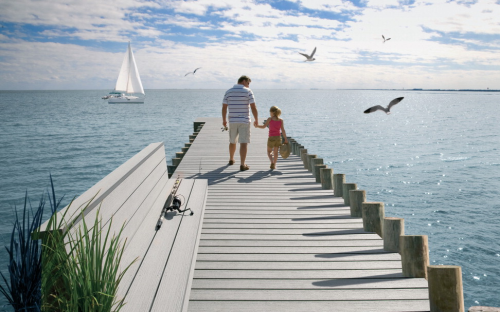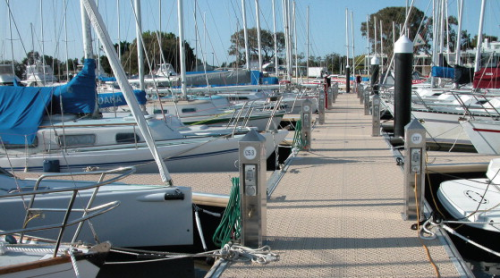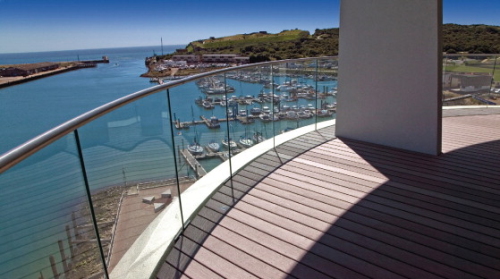


At one time, your average yacht or boat owner would row out to their precious floating asset by dinghy – often a wetting and logistically challenging process. Many owners today, perhaps the majority, access their craft dry shod via the thousands of pontoons and finger berths that secure the vessels and connect them to the land. Boaters increasingly rely on marinas, of which there are thousands – some 700 in the UK alone – with more being added all the time. Most of this infrastructure is made of traditional materials, but composites are beginning to make their presence felt. Several manufacturers and suppliers are now active in the market, which is split between new developments and marina redevelopment and/or pontoon refurbishment.
Given that there are thousands of miles of decking/walkway, this is where the potential is most apparent. Although wood – nature's own composite (cellulosic fibres in lignin) – is versatile, easily fabricated, biodegradable and has a cherished traditional feel, it can vary in quality and has limited life. Wood wears smooth, easily becoming slippery when wet. It can rot, suffer attack by marine organisms and may support the growth of algae. Walkway planks can sag and warp unevenly, creating a trip hazard. Even the hardwood walkways normally used are subject to these depravations and need replacing periodically.
Moreover, hardwoods are becoming more difficult to source and therefore more expensive, especially as environmentally aware marina users increasingly prefer the wood they walk on to have come from sustainably managed forests. In redevelopment and refurbishments projects, marina operators have to allow for the direct expense as well as the disruption involved in moving and temporarily re-mooring anything up to hundreds of craft, along with loss of goodwill from inconvenienced owners. For these reasons, anyone holding out the promise of extended service life for walkways is likely to be listened to carefully.
An example of how reinforced plastics can contribute recently arose at Brighton Marina, UK, where anti-slip, low-maintenance glass reinforced plastic (GRP) marine decking from The Grating Company (formerly ChemGrid) was installed as part of a major refurbishment of the fuel berth there. Marina infrastructure specialist Walcon Marine Ltd used the fibreglass product to replace the previous wooden decking on both the pontoon itself and the sloping access walkway to it. Walcon chose GRP grating, despite greater initial expense, because of its expected longevity in the aggressive coastal marine environment, low maintenance and good anti-slip properties even when wet and in the presence of spilt fuel.
The decking is made up of 2 m and 3 m by 1 m panels rather than the usual planks. Panels are moulded from standard E-glass fibres in orthophthalic polyester resin, with fire-retardant and ultraviolet (UV) resistant additives. Continuous unidirectional fibre tow reinforcement is used. Managing director Andrew Heseltine reports that interest in GRP decking, as well as other marina structures such as ladders, platforms, access slopes etc., has grown enormously in recent times, sales having doubled over the last two years, admittedly from a modest base.
“Clients are becoming more aware of the advantages of composites,” he told Reinforced Plastics. “These materials are highly durable and will last practically for ever. They are unaffected by salt or fresh water, acids and fuel, and withstand heavy usage. We find there's movement away from wood for durability and sustainability reasons.”
Mini-Mesh decking from The Grating Company has a pattern of small apertures through which water and other liquids can pass but which bars the way to small solid items that might otherwise ‘disappear’ when dropped. The company also supplies wide-mesh GRP gratings that offer a non-corroding alternative to galvanised steel platforms, steps and other items existing at marinas. Panels between 14 mm and 38 mm thick are shipped in from factories in China and India, along with pultruded profiles sourced from Europe. Clients can specify panels in green, grey or sandy colour.
An intriguing difference between the UK market and that in continental Europe, Heseltine adds, is that a grit surface is generally favoured in the UK whereas Europeans prefer a moulded-in pattern to confer the desired non-slip quality. While admitting that, unlike wood, GRP is not biodegradable, he points out that fibreglass does not have to be sent to landfill in sheets but can be shredded for end-of-life disposal.
Colin Burns, founder director of another company, Dura Composites Ltd, formerly Fibreglass Grating Ltd, indicates more advantages offered by GRP for decking and gratings.
“It weighs less than other materials and this makes it more manageable when assembling facilities on site. Two men can easily handle full panels without lifting equipment. Impact resistance is high and the material can deflect repeatedly without deforming permanently. GRP decking is safe for barefoot walking, unlike wood which can splinter.”
Burns says his company is working with all the main pontoon producers and believes that cost parity with wood cannot be far off. Dura Composites offers mini- and micro-mesh products which, like those of The Grating Company, are initially imported from the Far East. Its Marina Deck fibreglass grating system likewise offers high chemical resistance and weighs far less than conventional gratings. It is tough and has an anticipated service lifetime of up to 50 years. The company says that embedded quartz grit provides outstanding traction on the walking surface, especially in wet or icy conditions.
Dura Composites also supplies complete pontoon solutions. Dura Dock is a 100% composite pontoon that can be custom designed and is said to be equally suitable for new marinas and as a replacement for existing pontoons. It can be equipped with Marina Deck or Dura Deck decking depending on whether grip or aesthetics take priority. In Dura Deck, the non-slip pattern is moulded in.
Other composite decking products available include Globalgrid from FRP Resource LLC in California and Eon dock from CPI Plastics Group in Canada.
WPCs
Recently introduced Dura Deck is made from a type of timber/plastic composite generically known as wood-plastic composite. WPCs comprise wood flour mixed with resin and can thus be thought of as granular-reinforced plastics. The resin acts as a sealant against moisture ingress, adds strength and forms a hard scratch-resistant surface.
A wide range of properties can be achieved depending on the nature of the material components used and the wood/plastic ratio. WPCs suited for marina applications behave like wood, can be cut or routed with conventional woodworking tools and are dimensionally stable over time. However, they are more moisture resistant than wood and more resilient to weather, rot, mould growth, insects, cracking, splitting and splintering. They avoid the usual need for maintenance including sanding, sealing, staining etc. Warrantees of up to 25 years are offered for WPC products.
One specialist, TimberTech, produces WPCs that resemble wood and can be made in planks just like hardwoods. According to the company, solid-cored planks last better under high traffic conditions than hollow alternatives, although the latter have the advantage of lower weight. Care must be taken during manufacture, it says, to optimise the wood/resin mix since an excess of plastic could make the material prone to sagging and warping in hot climates and direct sun.
TimberTech makes its composite wood products from industrial waste taken, in the main, from the hardwood floor and furniture industries. Each year, the company uses over 100 million lbs of scrap that would otherwise end up in landfill. Resin used in decking planks is blended with UV-inhibiting pigments, enabling material to be produced in various colours. The pigments are highly reflective inorganic substances that minimise heat absorption, a potential problem especially in sun-exposed surfaces that are dark-coloured. Fade is said to be minimal.
As well as its decking planks, TimberTech produces DockSider, a material intended for use in docks, marinas and boardwalks. Planks 1.25 inch thick rather than the more usual 1 inch have the structural integrity to bridge a 2 ft on-centre span and remain stable over time. Planks are 5.5 inch wide. Nor, in the company's view, is the material ultimately more expensive. According to one of its press releases:
“Although the initial costs are higher, they are easily recouped over the product's lifespan through reduced annual maintenance and increased time before replacement.”
Steve Barnes, sales director of competitor KindaGroup, is equally enthusiastic, saying:
“WPCs are the future as hardwood prices, quality and supply are increasingly problematic. With this in mind, marina managers and pontoon suppliers are embracing materials that look better, reduce maintenance, are environmentally friendly and generate a greater return on investment.”
KindaGroup, already known for its KindaDek Marine WPC product, has used additive technology in developing a variant for Mediterranean and Middle East markets that can withstand very hot conditions. Another WPC product specified for Middle East use is a decking from Ireland's Earth-wood Composite Decking. This BS and BS-EN anti-slip approved system is also used throughout the UK and Europe.
Decking and walkways, though the most obvious application, are not the only infrastructure elements that benefit or could benefit from composites. Fibreglass gratings are used in finger berths, walkways and steps as well as pontoons. Glass reinforced concrete features in some pontoon floats. Entire pontoon structures are fabricated from composite pultruded profiles (e.g. Dura Dock). Lee Composites Inc in the USA uses GRP in seawalls, bulkheads, marine pilings, dock fenders and pipe hangers. And, where anti-slip is a leading requirement and existing structure is still in good condition, thin composite grating panels can be installed over existing decking. SlipGrip from FibreGrid Ltd is a 4 mm thick panel product based on polyester-impregnated glass woven matting. In one instance, when used as an overlay on access bridges at a leading UK east coast marina, its anti-slip properties were highly appreciated by marina clients, especially in frosty weather.
Competing
In these environment-conscious times, FRPs and WPCs have to battle competing environmental claims made for other alternatives to hardwoods. For example SolDeck, a new synthetic decking distributed by Solent Marine of Hamble, near Southampton, UK, is made from high-density polyethylene (HDPE). This plastic is recyclable whilst offering many of the same advantages as WPC – hard wearing, durable, splinter-free, rot resistant, UV-stable and fire-resistant. With its fibrous surface appearance, it is said to resemble wood. On the downside, it is heavier than hardwood. Solent Marine also utilises Dura Composites' fibreglass grating in its Stranraer pontoon system. Director Marc Simmonds has no doubt that marina owners are becoming more environmentally aware, while also facing concerns about long-term costs of maintenance and replacement.
“These facts point to the greater use of composite decking materials which reduce the use of tropical hardwoods,” he argues. “Advanced materials that resist UV, salt water and biological attack will ensure that marine decking lasts longer and looks fresher throughout its life.”
Dutch company Lankhorst Recycled Products uses recycled plastic granulate in its KLP Deck product and says that the result, in use for over 30 years, looks like wood but does not splinter or become slippery when wet. Used with KLP-S, a steel reinforced plastic beam, it can create a single span of up to 5 m, a useful attribute in pontoon construction. Company director Sjouke Tjalsma says that environmental concern continues to grow and that recycled plastics used in plastic decking are a solution.
Lankhorst also uses recyclate in sheet piling.
Over the border in Belgium, Govaerts Recycling NV claims similar advantages for its recyclate-based GovaDeck boards used for decking pontoons, jetties, walkways and breakwaters.
French marina systems provider Poralu Marine, although best known for its aluminium infrastructures, uses 100% recyclable polypropylene in its Ecostyle decking product. A particular advantage claimed for this material is that it allows light to filter through to fauna and flora on the seabed. Poralu could conceivably have added a fibre reinforcement to make its material a composite, and could still do so if some future load-bearing application were to require higher stiffness and strength.
Canadian company ThruFlow has, however, already done this, glass reinforced polypropylene (PP) being the material basis for its interlocking decking panel system. ThruFlow is interesting because, in principle, reinforced thermoplastics address the Achilles heel of thermoset FRPs, their non-recyclability, thermoplastics being repeatedly re-usable.
Poralu also markets a WPC-based product. Ecotek is made from 70% wood and 30% high density polypropylene (HDPP) and is claimed to be 100% recycled and recyclable. It is also reported to look like newly laid wood while being soft and warm to the touch.
Recycled plastics may not be suitable for use everywhere. The manager of a marina in Auckland has expressed doubt about recycled plastic because of high UV values in New Zealand and the embrittlement that could result. On WPCs, though, he is prepared to reserve judgment until there is more service experience. Generally, he maintains an allegiance to well-proven timber and concrete deckings, along with similarly traditional support materials.
It is fair to say that this view is typical of the majority of marina owners and operators. Risks associated with traditional materials are well understood, raising no new issues for managers and insurers for instance. Few in the marina business wish to stake their reputations on new systems with short track records in their sector. Fortunately, though, some in the business are prepared to be more forward looking.
For instance, Co Schot, director of the Port Zelande Marina in the Netherlands, holds that hardwood pontoons are ‘no longer the done thing’ and believes that the future lies with other solutions. Manager, special projects, at the same marina Monica de Vast, thinks that most of the alternative decking solutions are better for the environment than hardwood and expects that sustainability considerations will increasingly favour them.
A source at a leading UK marina developer that is basically agnostic about the technology used and chooses on a case by case basis, reports that:
“We are getting more requests to include composite options in our bids for new work. In fact, we are considering proposing a composite decking for a major redevelopment project on the East Coast right now. Ideally, we'd like something that looks like wood and has equal aesthetic appeal, but lasts for 25 or more years rather than 10 or 12.”
This succinctly summarises the challenge facing the composites community in breaking into this potentially lucrative market whose scale is hardly niche. The technical challenge is compounded by the familiar struggle to break down the barriers of conservatism and inertia surrounding established practice.




